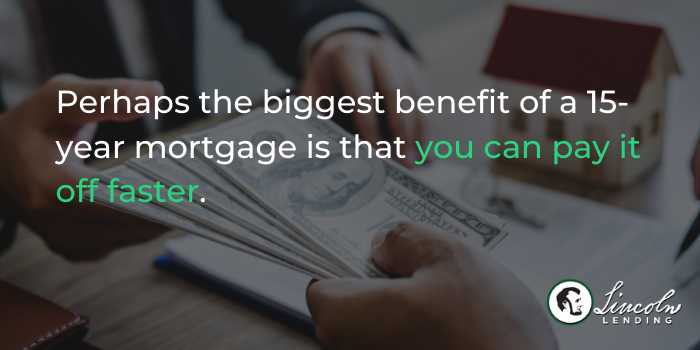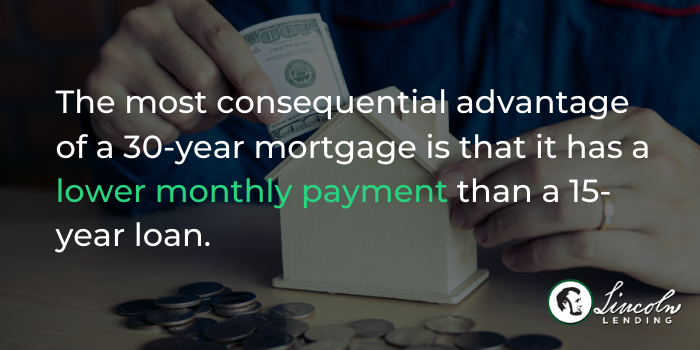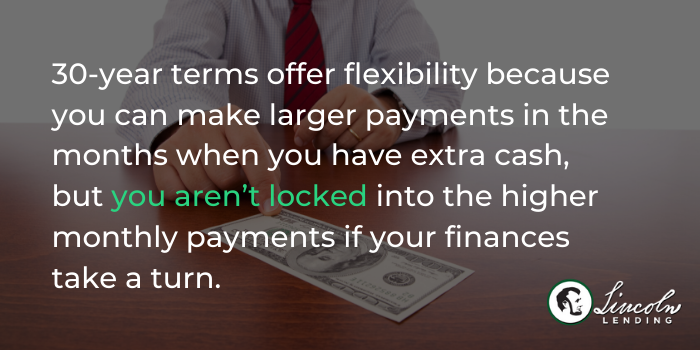Homeownership can be very rewarding, but it’s also a major commitment in both money and time. Anyone who has dipped their toes into the process knows that the pressure to find a mortgage with favorable terms can be overwhelming, especially if you’re a first-time buyer.
But what mortgage length is right for you? 15 and 30-year mortgages are the most common, but before you lock yourself into a loan, you should understand the pros and cons of each to make sure you get the best one for your finances and future goals.
Short-term mortgages – 15 years
Though a 30-year mortgage is the most common and many homebuyers assume that they must accept the 30-year term, there is another option: to pay off your mortgage (and fully own your home) sooner with a 15-year loan.
In most cases, the 15-year loan will have a lower interest rate and lower total interest cost but will have a higher monthly payment than a 30-year loan.
Pros of a 15-year mortgage
Perhaps the biggest benefit of a 15-year mortgage is that you can pay it off faster. This option is ideal if you are planning to stay in the home for a longer period of time and don’t want to be shackled to a mortgage payment for several decades. Your mortgage payment is a huge monthly expense, but with that payment out of the picture in half the time, you can focus on other things like preparing for retirement.

If you’ve ever taken out a loan, you understand what interest is and how quickly it can add up. A good rule of thumb is the shorter the loan term, the lower the interest. Because you are paying off the loan in 15 years rather than 30, you’ll pay much less interest over the life of the loan.
Your property is a financial investment, and you’ll build equity faster with a 15-year mortgage. Equity is the difference between your house’s value and what you owe to your home lender. It builds as your property value increases and your mortgage balance decreases, so with a 15-year mortgage, you can build equity at a faster rate.

Cons of a 15-year mortgage
The primary disadvantage of the 15-year mortgage is the higher monthly payments. Because you’re paying the loan off in half the amount of time, you’ll have a larger monthly payment.
If you can afford to put more toward your housing expenses each month, then a 15-year loan could be a great choice for you. However, if your housing budget is tight, you may not be comfortable allocating such a large portion of your monthly income to your mortgage. Also, if your income fluctuates, it may be risky to lock yourself into a large monthly payment.
Long-term mortgages – 30 years
What about a longer mortgage length? A 30-year mortgage is the most traditional and makes good financial sense for many homebuyers. In general, the 30-year loan will have a higher interest rate and higher total interest cost but will have a lower monthly payment than a 15-year loan.
Pros of a 30-year mortgage
The most consequential advantage of a 30-year mortgage is that it has a lower monthly payment than a 15-year loan. Your financial situation can change rapidly — one day, you may be earning big bucks at your steady office job, but the next day you could find yourself at the unemployment office.

Selecting a traditional 30-year mortgage with lower payments can provide you with some security and peace of mind in the face of economic and employment uncertainty. Since a longer-term mortgage has a smaller monthly payment, it can help you manage any financial mishaps more easily.
A 30-year mortgage can also help you keep more cash in your pocket and allow you to increase your personal savings. With this extra money, you can pay off credit card debt or make home improvements to increase the value of the property. After you accomplish these goals, you can always put some extra money toward your mortgage payments.
30-year terms offer flexibility because you can make larger payments in the months when you have extra cash, but you aren’t locked into the higher monthly payments if your finances take a turn.

Cons of a 30-year mortgage
The primary disadvantage of a 30-year mortgage is the interest. In general, you’ll have higher total interest costs when you take out a long-term mortgage because you are paying interest for a longer time.
For example, if you get a home loan for $200,000 at 4% interest, you’ll pay $66,288 in interest over the life of a 15-year loan. If you finance that same property with the same interest rate for 30 years, you will pay $143,739 in interest over the 30 years.
A note on other mortgage lengths
The 15 and 30-year mortgage lengths are not your only options. Lengths like 10, 25, and 40-years also exist but are not as common. Keep in mind too that not all lenders offer these options. Though these lengths might not be as common, it doesn’t mean that one wouldn’t be right for you.
Speak with a home loan coach
If you’re not sure which loan length would be best for your financial situation and goals, schedule a consultation with a Lincoln Lending home loan coach. We’ll guide you through choosing a loan length, fixed or variable interest rate, and even how to improve your credit score to get the best interest rate possible. Let us help you achieve your dream of homeownership!
